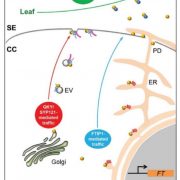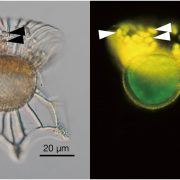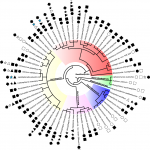Seed predation selects for reproductive variability and synchrony in perennial plants (New Phytol.) ($)
 Instead of regularly flowering and fruiting each year, some long-lived species exhibit annually variable reproduction events. This phenomenon, known as masting, is considered an adaptation to reduce the losses from seed predation: in years of high reproduction, seeds are so abundant that predators become satiated well before consuming all seeds, while in low production years, predators starve and reduce their density. Still, whether seed predation drives the evolution of masting has seldom been formally tested. Using a database of 12-20 years of observations, Bogdziewicz et al. assessed the relationship between pre-dispersal seed predation and masting behavior (i.e., annual seed production, interannual variability, and among-plant synchrony) in seven plant species. The authors found evidence of selection by pre-dispersal predation in all but two plant species. Despite this, pre-dispersal predation selected different masting characteristics in the other five species, either reproductive synchrony, interannual variability, or both. To explain these differences, the authors discuss that different seed predators with different life histories and characteristics impose different selective pressures on plants. As a result, this research provides an interesting framework for futures studies about the evolution of masting. (Summary by Carlos A. Ordóñez-Parra @caordonezparra) New Phytol. 10.1111/nph.16835
Instead of regularly flowering and fruiting each year, some long-lived species exhibit annually variable reproduction events. This phenomenon, known as masting, is considered an adaptation to reduce the losses from seed predation: in years of high reproduction, seeds are so abundant that predators become satiated well before consuming all seeds, while in low production years, predators starve and reduce their density. Still, whether seed predation drives the evolution of masting has seldom been formally tested. Using a database of 12-20 years of observations, Bogdziewicz et al. assessed the relationship between pre-dispersal seed predation and masting behavior (i.e., annual seed production, interannual variability, and among-plant synchrony) in seven plant species. The authors found evidence of selection by pre-dispersal predation in all but two plant species. Despite this, pre-dispersal predation selected different masting characteristics in the other five species, either reproductive synchrony, interannual variability, or both. To explain these differences, the authors discuss that different seed predators with different life histories and characteristics impose different selective pressures on plants. As a result, this research provides an interesting framework for futures studies about the evolution of masting. (Summary by Carlos A. Ordóñez-Parra @caordonezparra) New Phytol. 10.1111/nph.16835









